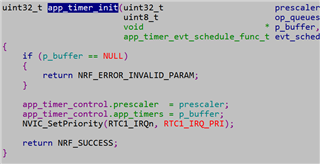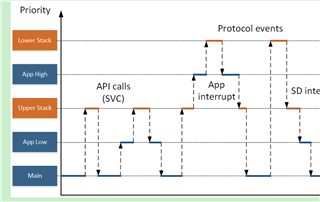Dear friends,
In the Power Profiling Application (an example of nordic SDK), the priority of the application timer is set to APP_LOW(as shown in the pic below).


However, according to the pic below, as sd_app_evt_wait() is a SVC, how can the application timer with a lower priority wake up the SOC ?

(1) In this application, if the SOC was waken up by the timer before connection event, does the notification data still have to be send until the coming connection event? That to say, the sd_ble_gatts_hvx() just copies the data into the radio buffer? and during an interval,there may be multiple tx phases? In addition, if the SOC was waken up at the connection event time, what will happen?
(2) what is the size of Radio buffer?
(3) During an interval, there may be four kinds of frame? such as: payload frame from M and empty ack frame from S; payload frame from M and payload frame from S; empty frame from M and payload frame from S; empty frame from M and empty ack frame from S?


